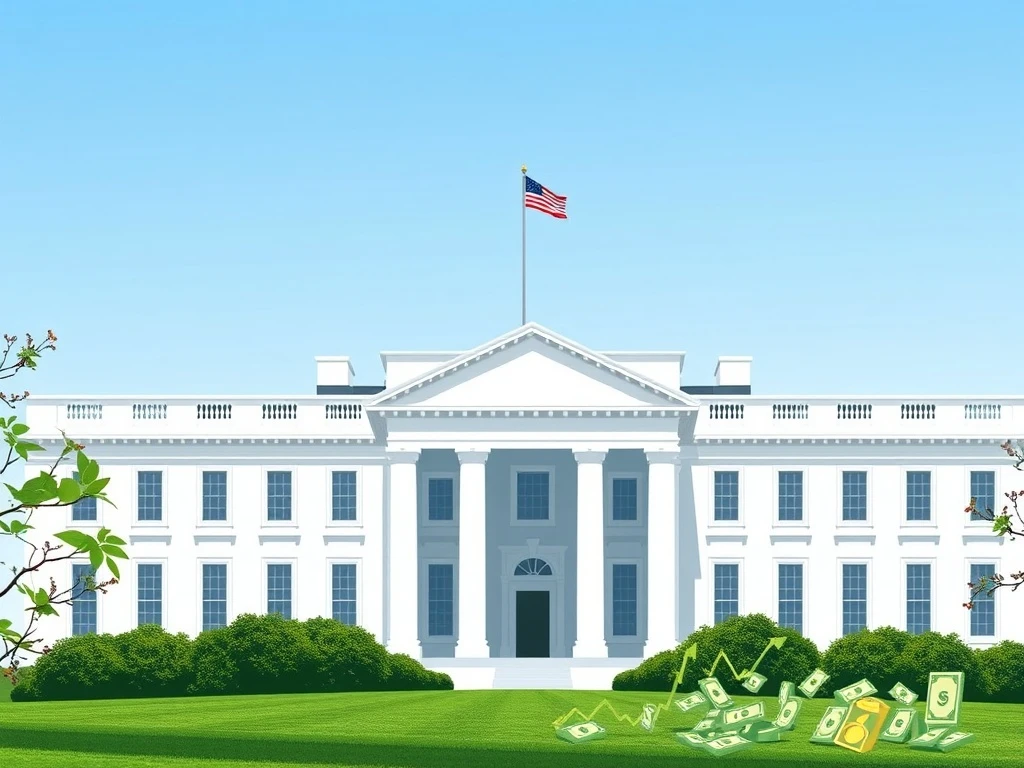A significant development has emerged from Washington, D.C., capturing the attention of economists, investors, and everyday citizens alike. The White House has reportedly pitched a plan for substantial Fed interest rate cuts, potentially commencing as early as September. This proposal signals a strong desire from the administration to influence the nation’s monetary policy, aiming to spur economic activity. Consequently, this bold move could reshape the financial landscape, affecting everything from borrowing costs to investment returns.
The White House’s Push for Deeper Fed Interest Rate Cuts
Reports indicate the White House is actively advocating for significant adjustments to the Federal Reserve’s benchmark interest rate. The administration’s focus appears to be on initiating these Fed interest rate cuts in September. This push likely stems from a desire to stimulate economic growth and alleviate financial pressures on consumers and businesses. Furthermore, lower interest rates typically make borrowing more affordable, which can encourage spending and investment.
The White House’s rationale centers on several economic indicators. Officials may believe that current interest rates are too restrictive, hindering the economy’s full potential. Therefore, a reduction could foster a more dynamic environment. This proactive stance highlights the administration’s commitment to achieving specific economic objectives, including robust employment and stable prices. However, the Federal Reserve operates independently, making its own decisions based on economic data and its dual mandate.
Understanding ‘Jumbo’ in Fed Interest Rate Cuts
The term “jumbo” in the context of Fed interest rate cuts refers to a reduction larger than the typical 25-basis-point increment. A jumbo cut usually implies a decrease of 50 basis points (0.50%) or even more. Such a substantial move would signal a strong shift in the Federal Reserve’s monetary policy stance. Moreover, it would indicate a significant response to prevailing economic conditions.
Consider these key points about jumbo cuts:
- Magnitude: A 50-basis-point cut is twice the size of a standard rate reduction.
- Urgency: It often suggests the Fed sees a pressing need to stimulate the economy or address a slowdown.
- Market Impact: Jumbo cuts can trigger more pronounced reactions in financial markets due to their larger scale.
Ultimately, a jumbo cut would be a powerful signal to the markets and the public. It would underscore a more aggressive approach to adjusting monetary policy, potentially accelerating economic changes.
Potential Economic Impact of Steep Fed Interest Rate Cuts
Significant Fed interest rate cuts could ripple through various sectors of the economy. Lower interest rates generally translate into reduced borrowing costs for consumers and businesses. Consequently, this can stimulate economic activity across the board. However, there are also potential drawbacks to consider.
The primary impacts include:
- Consumer Spending: Mortgages, auto loans, and credit card interest rates could decrease. This reduction frees up disposable income, potentially boosting consumer spending.
- Business Investment: Companies find it cheaper to borrow for expansion, equipment, and hiring. This encourages capital expenditure and job creation.
- Inflation: A potential risk is renewed inflationary pressure. If demand outstrips supply too quickly, prices could rise again.
- Savings: Savers might see lower returns on their bank deposits and fixed-income investments.
- Exports: A weaker dollar, often a consequence of lower rates, can make U.S. exports more competitive abroad.
Therefore, while stimulating growth, policymakers must carefully balance these effects to maintain overall economic stability. The full implications of any jumbo Fed interest rate cuts would unfold over time, requiring continuous monitoring.
Market Reactions and Investor Outlook to Fed Interest Rate Cuts
Financial markets typically react swiftly to news concerning Fed interest rate cuts. Investors constantly price in expectations of future monetary policy. A concrete proposal from the White House, even if not a direct Fed decision, can certainly influence market sentiment. This anticipation often leads to immediate shifts in asset prices.
Here’s how different markets might respond:
- Stock Market: Lower rates often boost corporate profits by reducing borrowing costs and encouraging consumer spending. Therefore, equity markets typically react positively.
- Bond Market: Bond prices tend to rise as interest rates fall, and bond yields decrease. This makes existing bonds with higher yields more attractive.
- U.S. Dollar: The dollar might weaken against other major currencies. Lower interest rates make dollar-denominated assets less attractive to foreign investors.
- Real Estate: Lower mortgage rates could stimulate the housing market, increasing demand and potentially home prices.
Ultimately, market participants will closely watch the Federal Reserve’s actual statements and economic data. Their reactions will reflect not only the White House’s pitch but also the Fed’s independent assessment of the economy.
The Federal Reserve’s Independence in Setting Interest Rates
The Federal Reserve operates as an independent central bank, insulated from direct political pressure. This independence is crucial for its ability to make sound monetary policy decisions based on economic data rather than short-term political cycles. The Fed’s dual mandate guides its actions: achieving maximum employment and maintaining price stability (low and stable inflation). Therefore, any White House proposal regarding Fed interest rate cuts serves as an input, not a directive.
The Federal Open Market Committee (FOMC) is the primary policymaking body within the Fed. Its members carefully analyze a wide range of economic indicators before making decisions on interest rates. These indicators include inflation data, employment figures, GDP growth, and consumer spending. Consequently, the FOMC’s decisions are data-dependent and aimed at achieving its long-term objectives. The Fed’s Chair often emphasizes this commitment to data-driven policy.
Historical Precedents of Fed Interest Rate Cuts
The Federal Reserve has a long history of adjusting interest rates in response to economic conditions. Historically, Fed interest rate cuts have been implemented during periods of economic slowdown or crisis. For instance, the Fed significantly lowered rates during the 2008 financial crisis and again in response to the economic shock caused by the COVID-19 pandemic in 2020. These actions aimed to inject liquidity and stimulate recovery.
However, each period presents unique challenges and contexts. The reasons for past rate cuts vary, from combating recessionary pressures to providing support during unforeseen events. Learning from these historical precedents helps inform current policy discussions. Nevertheless, the present economic environment, including inflation levels and labor market dynamics, dictates the appropriateness of any new rate adjustments. Therefore, the Fed considers all available information before making its moves.
Challenges and Risks Associated with Aggressive Fed Interest Rate Cuts
While Fed interest rate cuts can stimulate growth, aggressive reductions also carry inherent risks. Policymakers must weigh these potential downsides carefully. One primary concern is the possibility of reigniting inflation. If rates fall too quickly, demand could surge, outstripping supply and leading to higher prices. This would undermine the Fed’s goal of price stability.
Other challenges include:
- Asset Bubbles: Excessively low rates can inflate asset prices (stocks, real estate) beyond their fundamental value, creating bubbles that could burst.
- Financial Stability: Rapid rate changes can introduce volatility into financial markets, potentially creating instability.
- Reduced Policy Levers: If rates are cut too deeply, the Fed has less room to maneuver in a future downturn.
- Credibility: The Fed’s credibility could be questioned if its actions appear influenced by political pressure rather than economic fundamentals.
Ultimately, the Federal Reserve must navigate these complexities. Its decisions aim to balance the need for economic support with the imperative of maintaining long-term stability and avoiding unintended consequences.
What Lies Ahead for Fed Interest Rate Cuts?
The White House’s proposal for Fed interest rate cuts starting in September sets a significant expectation. However, the ultimate decision rests with the Federal Reserve. Market participants will closely monitor upcoming economic data releases. Key indicators include the Consumer Price Index (CPI) for inflation, employment reports, and retail sales figures. These data points will heavily influence the Fed’s assessment of the economy’s health.
The FOMC holds regular meetings to discuss monetary policy. The September meeting will be particularly scrutinized for any signals regarding rate adjustments. Investors often use Fed Funds futures to gauge market expectations for future rate moves. Furthermore, public statements from Federal Reserve officials, including Chair Jerome Powell, will provide crucial insights into their thinking. The path forward for interest rates remains data-dependent and subject to ongoing economic developments.
The White House’s recent pitch for jumbo Fed interest rate cuts starting in September underscores a clear desire to invigorate the economy. This bold proposal highlights the administration’s focus on fostering growth and easing financial burdens. However, the Federal Reserve maintains its independence, basing its monetary policy decisions on a comprehensive analysis of economic data and its dual mandate of maximum employment and price stability. The coming months will reveal how the Fed responds to evolving economic conditions and whether it aligns with the White House’s ambitious timeline. Ultimately, the interplay between political aspirations and independent monetary policy will shape the nation’s financial future.
Frequently Asked Questions (FAQs)
1. What does ‘jumbo’ mean in the context of Fed interest rate cuts?
In monetary policy, a “jumbo” cut typically refers to an interest rate reduction larger than the standard 25-basis-point (0.25%) increment. It usually means a cut of 50 basis points (0.50%) or more. This signals a more aggressive or urgent policy shift by the Federal Reserve.
2. How might jumbo Fed interest rate cuts affect my mortgage or loans?
Significant Fed interest rate cuts generally lead to lower borrowing costs for consumers. If you have a variable-rate mortgage, its interest rate could decrease. For new loans, such as mortgages, auto loans, or personal loans, the rates offered by banks are likely to become more favorable, making borrowing cheaper.
3. Will these proposed Fed interest rate cuts lead to higher inflation?
There is a risk that aggressive Fed interest rate cuts could contribute to higher inflation. Lower rates stimulate demand by making borrowing cheaper and encouraging spending. If this demand outpaces the economy’s ability to produce goods and services, prices could rise, potentially undoing progress made on inflation control.
4. Is the Federal Reserve influenced by political pressure from the White House?
The Federal Reserve is designed to be an independent central bank. While the White House or other political entities may express their views or preferences, the Fed’s policymaking body, the FOMC, makes decisions based on economic data and its dual mandate of maximum employment and price stability, not political pressure. Its independence is crucial for long-term economic stability.
5. What economic data does the Federal Reserve watch for rate decisions?
The Federal Reserve closely monitors a wide range of economic data to inform its interest rate decisions. Key indicators include inflation rates (like the Consumer Price Index and Personal Consumption Expenditures), employment figures (job growth, unemployment rate, wage growth), Gross Domestic Product (GDP), consumer spending, and business investment data. These provide a comprehensive picture of the economy’s health.








